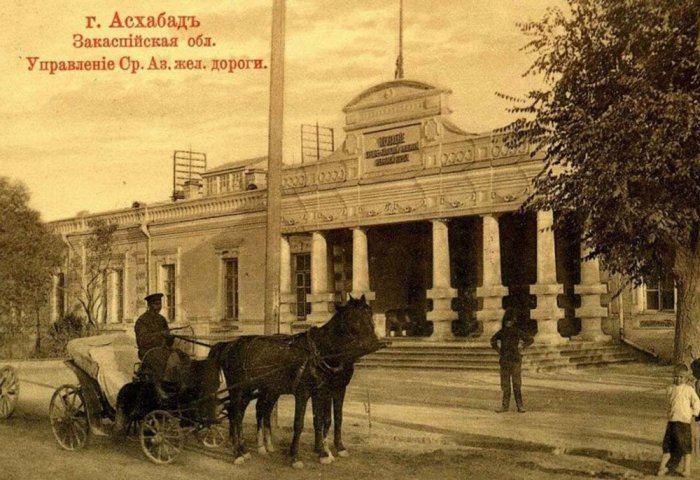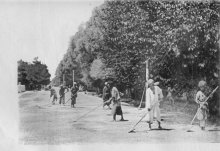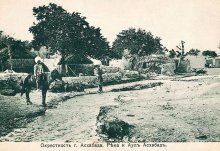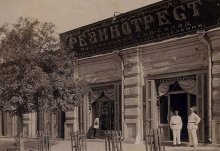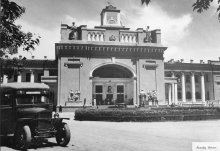An illustrated guide to the Central Asian Railway, published in the pre-revolutionary period, testifies to the following. Among the most notable buildings of Askhabat at that time we can highlight: the buildings of the Central Asian Railway Administration,
Transcaspian Customs District, Treasury and Branch of the Russian-Asian Bank. And from the buildings of educational institutions: a gymnasium (male and female) and a technical railway school.
Due to the fact that Askhabat at that time was the scientific centre of the region, it had a large number of educational institutions in comparison with other settlements, however, they did not satisfy the needs of the population wishing to receive an education and a specialty in any profession. In order to train teachers from the local population, it was decided to establish five government scholarships in the classes of the Turkestan Seminary of Teachers and the same number in the Askhabat Zemstvo.
Askhabat itself was a well-maintained city. Straight wide streets, lined on both sides with trees in one, and on some streets - in two and three rows.
The abundance of greenery made it possible to move away from the practice of building residential buildings inside courtyards. New buildings began to face the street. Houses appeared that met strict architectural requirements. For example, the above-mentioned educational institutions (gymnasiums), the house of the Red Cross Society, the buildings of the Military and Bicycle clubs.
The emerging dust was absorbed by water from ditches by specially hired workers.
The lack of water made it possible to water the streets only after a certain period of time. Askhabat was then irrigated with water from two mountain rivers: Askhabat and Keshin, the water of which was used to water the city. Kariz water was used for drinking.
Street lighting was provided by kerosene-heat lanterns.
Two newspapers were published in the city: Transcaspian Review (K. Oedorova) and Askhabat (Z. Javronova). Newspapers were printed in private printing houses.
There were four clubs in the city: two are listed above, and there were also Sport and English. But the most comfortable were Military and Bicycle. They had spacious halls, sometimes adapted for performances by visiting troupes and touring singers. The building of the Dobrojanskaya Circus was also used for the same purposes. Since visiting these establishments was expensive, ordinary residents used the services of cinema theaters: Elje, Modern and Art. The latter, by the way, was considered the best.
In Askhabat there was a city garden with a mass of varied vegetation and an extensive flower garden, as well as Kozelkovskiy and Pushkinskiy squares, the latter with a monument to the poet.
The special conditions of the city, which was the centre of the administrative structure of the Trans-Caspian region, contributed to the fact that it was simultaneously a center of domestic and foreign trade. And this, in turn, created the preconditions for the emergence of a large number of trading enterprises of various directions.
It is worth mentioning only a few of them: stores of Kruglov, ready-made clothes of Medvedev and Gulnazarov, carpets of Sadykov and Yunusov. Fashion and haberdashery goods – Petrosyants. Wine and gastronomic stores - Korolev. Confectionery shops – Poteryahin and Grigoriyev. Stationery supplies - Sorokin and Osokin. Tableware and lamp stores of Kachachev and Kerimov. Furniture stores - Gayamov. Pharmacies of Pavlotskiy. Soap factory Ter-Mikirtychev. Butuzov brick factory. Leather and lime - Popov. Flour mill - Avetisov.
Among the medical institutions in Askhabat there were city and railway hospitals, a military hospital, the Minkevich hydropathic clinic and private outpatient clinics for doctors.
Near Askhabat there were schools of horticulture, gardening and sericulture, which had nurseries.
The history of Ashgabat (Askhabat) has its roots in the distant past, and what is presented is only a small part of the past of the capital of independent neutral Turkmenistan.
Allaberdi Niyazov
The article was published on the website "Turkmenistan: Altyn Asyr" on May 25, 2024.

